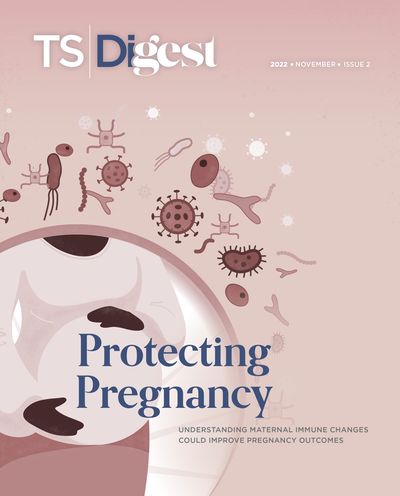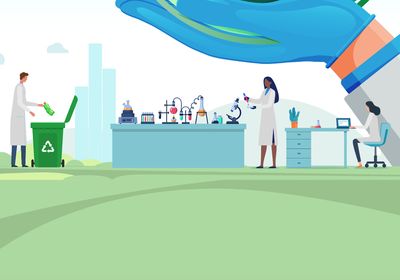ABOVE: MODIFIED FROM © ISTOCK.COM, ALEKSEI NAUMOV
During the pandemic, postdoc Julie Sesen started to feel overwhelmed by the amount of plastic used by the scientific community. Sesen studies pediatric tumors and cerebrospinal disease at Boston Children’s Hospital (BCH), where in 2020 many researchers were testing the community for COVID-19. Every day, researchers there and at scientific centers across the country inevitably threw away hundreds of single-use masks and plastics. Everyone she spoke to agreed that the volume of plastic waste was an issue, she says. “And we needed to do something about it.”
Even before the pandemic, researchers worldwide produced several million tons of plastic waste per year, according to some estimates. But when Sesen looked into how she could recycle the waste she was generating in her lab, she learned that plastic waste was only part of a larger problem. Scientists also use massive amounts of energy, exacerbating pollution and contributing to climate change. Various estimates indicate that a research lab can consume more than three times as much energy as an office of the same size. Common equipment such as fume hoods and ultra-low-temperature freezers can consume as much as an average household. So when Sesen discovered My Green Lab, a nonprofit that seeks to help scientists improve sustainability in research labs, she soon joined their Ambassador program, which provides free online courses on sustainable science. She and another postdoc went on to found BCH Greenlabs, an initiative to support other research groups at the institution in reducing their carbon footprint and plastic waste.
The huge environmental impact of laboratory research has led many other institutions to try to make research eco-friendlier, too. There are now hundreds of such programs around the world, developed either in-house or in partnership with organizations such as My Green Lab. Some initiatives, like the one at BCH, are mainly run by volunteers, typically students and postdocs, while other institutions have a sustainability office overseen by one or more paid specialists. Taking advantage of the increased uptake of sustainable lab practices, advocates are now taking the opportunity to push for larger, systemic change. While the COVID-19 pandemic has hindered some of these efforts, it has also motivated people to do more, researchers tell The Scientist. In a handful of countries, sustainable practices may even soon be tied to grant funding, notes Anna Lewis, a sustainable science manager at the University of Bristol in the UK, making a green approach an integral part of life sciences research.
“The momentum is incredibly good right now. . . . We’re seeing an explosion of green labs,” says My Green Lab CEO James Connelly. “But we do need those systemic levers [for science] to be part of the climate solution and not part of the climate challenge.”
A wave of lab sustainability programs
Although most researchers are open to adopting greener laboratory practices, the “scientific industry as a whole has been a bit slow to address climate change,” says Connelly. Indeed, when My Green Lab first started in 2013, it had partnerships with only 10 schools. Now, it works with more than 1,000 labs in 36 countries, including several biotechnology companies. The organization offers a voluntary certification process in which researchers assess a lab’s current energy usage, equipment usage, and chemical and waste disposal system. They send these assessments to My Green Lab, which makes suggestions for improvement. “These are low-cost or zero-cost things that any researcher can do to help improve the sustainability of scientific research that also don’t undermine or interfere with . . . research,” says Connelly. Simple suggestions include actions like closing the fume hood sash, which can reduce energy consumption by up to 30 percent, and setting ultra-low temperature freezers to –70 °C instead of the standard –80 °C, which can reduce the appliances’ yearly energy consumption by 30 percent.
Another popular certification scheme is the Laboratory Efficiency Assessment Framework (LEAF), which was developed at University College London and is now used at several schools in the UK. Schools that adopt it typically have a centralized office to help implement LEAF, but it’s up to individual labs to opt in. Like many other sustainability initiatives, LEAF mainly focuses on life science laboratories because they “have a lot of common, energy-intensive equipment,” says Lewis, who helps oversee LEAF at Bristol. Most of the guidance encourages behavioral changes, such as remote participation in conferences, reusing solvents, and cataloging chemicals and samples to avoid over-purchasing supplies. Although participation is voluntary, 100 percent of Bristol’s 1,000 laboratories have adopted LEAF, Lewis says.
Increasingly, green life science efforts are being seen as part of larger, institute- or municipality-wide commitments to improving sustainability.
Some institutions have launched their own sustainability programs. The University of Colorado Boulder started its initiative, CU Boulder Green Labs, back in 2009. Program manager Kathryn Ramirez-Aguilar says that the effort initially focused on “energy savings, water savings, waste diversion, [and] scientists’ engagement,” which meant getting individual labs to change their practices. More-recent initiatives include university-wide equipment sharing programs, which Ramirez-Aguilar says has not only saved energy and reduced unnecessary purchases but improved equal access to resources. She says she hopes that in the future, CU’s lab startup packages will include access to this shared equipment.
Increasingly, green life science efforts are being seen as part of larger, institute- or municipality-wide commitments to improving sustainability. The University of California (UC) system, for example, has partnered with My Green Lab as part of its pledge to achieve carbon neutrality by 2025, and UC has made it a goal to certify three laboratories on every campus under its umbrella by the end of this year. Similarly, the University of Bristol adopted LEAF to reach a 2030 carbon neutrality target, set after the city of Bristol passed a resolution in 2015 to hit a similar target.
Because sustainability programs are largely voluntary, it’s difficult to know exactly how many labs at certain institutions have adopted green practices. Similarly, because academic institutions are large and labs may share building space, it can be hard to track how much energy purely behavioral initiatives save.
Still, the organizers of many green lab projects say they’ve saved energy and diverted waste from landfills. LEAF’s pilot program, which took place from 2018 to 2020 at 23 universities, reportedly saved 648 tons of carbon, the equivalent of taking 140 passenger vehicles off the road for those two years. Recently, the University of British Columbia’s Michael Smith Laboratories (MSL), a group of more than 300 researchers, participated in UBC’s Chill Up Challenge, its version of the Freezer Challenge competition organized by My Green Lab and the International Institute for Sustainable Laboratories (I2SL). The University saved 45,000 kilowatt hours of electricity in a year, equivalent to the annual usage of four single-family homes. And since 2009, CU Boulder’s Green Labs program has saved 9.1 gigawatt hours of energy (equivalent to $1 million), says Ramirez-Aguilar, as well as conserved 61 million gallons of water and diverted 376,000 pounds of waste.
Obstacles to making science more sustainable
Overwhelmingly, sustainability coordinators and volunteers say that scientists are enthusiastic about making their research more environmentally friendly, even though they sometimes lack the tools and know-how to do it. But some also say that getting busy scientists to take action is a challenge. “Even if scientists are aware of the environmental impact of research . . . there’s this sense that ‘There’s nothing I can do about it’ or ‘This science is too important that the environmental impacts are worth it,’” says Connelly. In addition, not all schools have the resources to put these programs into practice. “The challenge is funding. I don’t really have funding for large-scale changes,” says Carrie Metzgar, a sustainability and planning analyst at UC Irvine.
Costs can accumulate in various ways. For example, some changes require support from technical staff and environmental health and safety experts, all of whom are ideally also trained in sustainability. At the University of Bristol, Lewis says that technicians, who are knowledgeable about how to adapt their lab’s protocols and practices, provided the necessary support for Bristol to reach 100 percent LEAF certification. But she also admits that not all schools have this technical support.
Many waste mitigation strategies, not to mention equipment procurement and replacement, are more than scientists can do on their own, and some are costly up front. Recycling can be an especially difficult organizational task, as many research products must be recycled outside the municipal waste stream. For example, there are only three companies in the US that recycle single-use nitrile gloves, a laboratory fixture.
Similarly, while many biotech companies have begun taking back plastic waste, “the problem with that is often it’s restricted just to the items that they have sold you. That means the lab needs to have multiple lab plastic bins in the lab for different suppliers,” says Andrew Arnott, a climate strategy, biodiversity and sustainability manager at the University of Edinburgh. He adds that Edinburgh is attempting to incorporate recycling of these items into the municipal waste stream.
In some cases, thinking long-term may help universities provide labs with the needed up-front costs. The University of Bristol, for example, has a fund to replace laboratory equipment with energy-efficient models, giving researchers the amount of money that they would save over the course of seven years. And they’re not alone; many other universities have similar programs that help laboratories buy green equipment.
Efforts to bring about systemic change
Despite the growing enthusiasm for green labs, some proponents still say that they are working within a system that deprioritizes sustainability. Some behaviors like plastic use remain entrenched in scientific practice and continue to increase. Making sustainable laboratory practices standard in research laboratories will require incentives for researchers and companies to divert waste and save energy. “The climate crisis requires us to spend money on things which won’t necessarily give us a quick payback,” says Arnott.
One way to get the whole scientific enterprise more involved in sustainability may be to tie grant funding to green practices, says Ramirez-Aguilar. “I find that scientists want access to sustainable products and supplies,” she says. Prioritizing sustainability when allocating research funding “can drive the [systemic] changes needed.” In the UK, some grant funding agencies are already welcoming sustainability statements in grant applications. UK Research and Innovation (UKRI), the UK’s national science funding agency, has expressed interest in adopting LEAF as a standard for laboratory sustainability and incorporating it into grant decisions, says Lewis. “Green lab certification, LEAF for example . . . is very likely to be linked to grant funding opportunities in the next year or so,” she says. UKRI did not respond to a request for comment.
The US may soon follow. In October, the Department of Health and Human Services released its Climate Action Plan, which listed enacting sustainable grant policies as one of its priorities. So far, this hasn’t translated into any changes in the grant application process for any federal funding agencies, although National Institutes of Health (NIH) spokesperson Elise Rabin tells The Scientist in an email that the agency is “aware of the Department of Health and Human Services’ (HHS) climate goals as outlined in the HHS 2021 Climate Action Plan. . . While NIH awaits further direction from HHS, it has been reviewing NIH policies to see how we can achieve the objectives identified in the plan.” The NIH also says it supports green science initiatives and runs its own green labs program. HHS did not respond to a request for comment.
To push for faster change, My Green Lab and the I2SL have sponsored an effort called Million Advocates for Sustainable Science, a letter-writing campaign to funding agencies requesting that they do their part to promote sustainability in research. Martin Howes, the assistant carbon manager at Cambridge University, says he hopes that researchers won’t view and talk about sustainability and research as separate issues for much longer. “We’ve long had a strong safety culture. Sustainability needs to be the next one of those needs to integrate with safety culture and best practice.”
SIMPLE TIPS FOR A MORE SUSTAINABLE LABThe Scientist assembled advice from sustainability experts on how to reduce your research’s environmental impact. | |
Chill out: Regularly service your ultra-low temperature freezer and increase the temperature, if possible. Many samples can be held at –70 °C as opposed to the current standard default temperature of –80 °C. | |
Shut off: Power down equipment when not in use and set up timers on lights so that they’re not running all night. | |
Shut up: A single fume hood can consume as much energy as 3.5 homes. Shutting the sash on your fume hood can save up to $9,100 each year. | |
Recycle: Reach out to your facilities manager to learn more about how you might partner with companies that recycle common single-use items such as gloves, masks, and pipette tips and boxes. | |
Take stock: Regularly checking what your lab already has in stock can prevent unnecessary purchases. | |
Share it: Set up sharing programs with labor-atories nearby to avoid purchasing unnecessary equipment and improve equal access to equipment. | |








